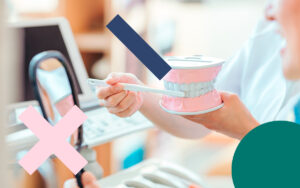Due to multiple causes, gums can suffer from hypersensitivity, which makes them much more vulnerable to external factors. Whether due to insufficient care and cleaning, some kind of illness, or after having undergone a deep dental cleaning, it is necessary to learn how to brush your teeth without damaging the gums so that their condition improves little by little.
Sensitive gums, which are inflamed or bleeding, gradually improve over time. Meanwhile, it is essential to provide them with the greatest care in times of vulnerability.
Do you know the dental brushing technique to avoid damaging sensitive gums? We explain how to do it properly according to the recommendations of dental experts.
What is gingival sensitivity?
Gingival sensitivity is the increased sensation of discomfort and pain in the gums due to inflammation of the soft tissue that covers the tooth. This corresponds specifically to a symptom of gingivitis, an infection of the gums that causes irritation, redness and inflammation of the gums.
The main cause of gingivitis, and therefore the appearance of sensitive gums, is poor oral hygiene, which favors the accumulation of tartar and the formation of dental plaque under the gum tissue that surrounds the teeth.
The longer dental plaque remains on the teeth, the more advanced the gum infection will be. Over time, gingivitis causes inflammation and bleeding, and can lead to periodontitis, one of the main causes of tooth loss in the patient .
How to brush your teeth with sensitive gums?
People with sensitive gums are more likely to experience discomfort while brushing. However, oral hygiene is of the utmost importance, and should be carried out with the same consistency as a person with good gingival health.
Following the proper guidelines, the pain caused by the sensitivity of the gums will be less or practically nil. It is very important to use a specific technique and accessories so that the gums do not hurt or bleed during brushing.
If you have sensitive gums, preferably use a soft or extra-soft gum or bristle brush, with a handle that allows you to hold it firmly. The toothpaste must be fluorinated, and in some cases, specific to treat dental sensitivity.
In addition to toothpaste and a brush, complete oral hygiene includes the use of dental floss, interdental brushes and mouthwash. The latter may contain chlorhexidine for the treatment of gingivitis, following the recommendation of your dentist or hygienist.
Brushing techniques for sensitive gums
There is a false belief among patients that the more pressure exerted with the brush on the teeth and gums during oral cleaning, the better the result. Excessively aggressive brushing has the opposite effect to that desired: it can cause damage, bleeding and recession in the gums, as well as progressive wear of tooth enamel.
Although there are different brushing techniques with which dentists instruct their patients to learn how to properly care for their oral hygiene, there is one in particular that is indicated for sensitive gums.
Through the Bass technique, you can learn how to brush your teeth without damaging the gums when there is some sensitivity.
Bass technique for patients with gingivitis or periodontitis
The Bass technique is a specific toothbrushing technique that focuses on the removal of dental plaque from the gingival sulcus. It is precisely in this space between the gum and the tooth where the plaque that causes gingivitis accumulates.
By making gentle horizontal sweeping movements along the gum line, it is possible to remove food debris and prevent the formation of dental biofilm in the gingival sulcus, improving the health of sensitive gums.
How to brush your teeth without damaging your gums step by step
Next, we are going to see how the Bass technique is carried out for brushing teeth on sensitive gums, avoiding irritation and bleeding:
- Start by applying a small amount of toothpaste to your toothbrush.
- Place the toothbrush horizontally on the gum line, just where it meets the tooth, at a 45-degree angle.
- Make horizontal vibration movements on the gingival sulcus, just over the junction between the gum and the tooth, covering one, two or three teeth depending on the size of your brush head, to reach the bottom of the sulcus.
- After a few seconds of vibrating movement, make a vertical dragging movement moving the brush gently from the gum towards the edge of the tooth.
- It covers the entire surface of the external face of the teeth, both the upper and lower dental arches. Once you have finished, repeat the operation on the inner face, placing the brush at a 45 degree angle.
- Take your time to do a complete and gentle cleaning, spending between 3 and 5 minutes to cover the entire surface of the teeth . Don’t forget to also brush the chewing surface of the molars and the tongue.
- If you notice discomfort or slight bleeding while brushing, the pressure exerted is higher than recommended. Correct the technique by making softer movements and without squeezing the brush on teeth and gums.
- Complete oral cleaning with the use of dental floss or interproximal brushes, as well as an alcohol-free mouthwash.
Remember that tooth brushing should be done at least 3 times a day, always after each meal.
It is very important that when performing this brushing technique, strong pressure is not applied with the toothbrush. Avoid irritation and bleeding of the gums, as well as the abrasion of dental enamel , by learning how to brush your teeth without damaging the gums with the Bass technique. If you notice that the bleeding persists, go to your dental hygienist, who will be your ally in improving your brushing technique.
BIBLIOGRAPHY
Information on periodontics. Gingivitis and periodontal disease – General Council of Colleges of Dentists and Stomatologists of Spain.
Periodontal health and gingivitis – European Federation of Periodontology.
Brushing techniques and areas of application. Barbara Kortemeyer.








